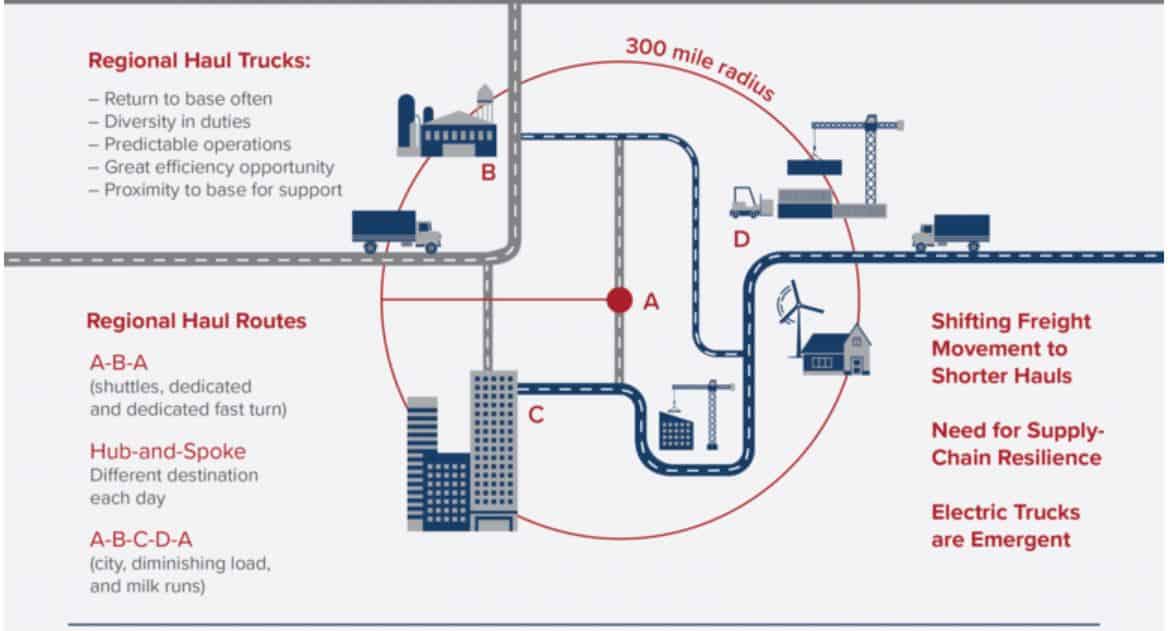Regional haul trucks, helping to keep food shelves stocked and critical medical supplies delivered during the global health pandemic, could save billions in fuel costs every year.
It would not be easy because regional haul has many definitions and the estimated 800,000 regional haul trucks may travel highways and cover short delivery runs on city streets in the same 24-hour period.
So, the North American Council for Freight Efficiency (NACFE) fuel savings estimate of $9 billion and reduction of 30.6 million tons of carbon dioxide a year should not be expected soon.
But the savings are possible based on what NACFE learned in October 2019 when it conducted a three-week “Run on Less Regional” fuel efficiency program involving trucks from 10 fleets. Demonstration data came from 58,000 miles of driving and 237 deliveries.
As reported in October 2019, the trucks, equipped with a variety of technologies to improve aerodynamic performance, averaged 8.3 miles per gallon (MPG), 38% greater than the typical 6.0 MPG. Nine diesel-powered trucks achieved an average of 8.7 MPG. One truck ran on compressed natural gas (CNG).
Second-highest cost
Fuel costs averaged around 43.3 cents per mile in 2018, accounting for 23% of fleet operating costs, second only to driver wages and benefits, according to the American Transportation Research Institute.
If such improvements are possible, why aren’t regional fleets doing more to improve fuel efficiency?
“Fuel economy is a cost of operations that is not top of mind,” said Mike Roeth, NACFE executive director. “The variety of these duty cycles is so significant that even in the dedicated fast turns they design more of a vanilla truck than one that is focused on getting good fuel economy while on the freeway because they may use that truck in a different operation.”
Regional haul involves at least seven variants – shuttle, dedicated, dedicated fast turn, hub and spoke, city, diminishing loads, and milk runs.
“Regional haul is not homogenous,” Roeth said. “You’ve got to get down to a level of detail before you can design, sell and buy technologies.”
For example, a United Parcel Service (NYSE: UPS) truck that participated in the demonstration might complete fast turns during the day but deal with diminishing loads during a night shift. The UPS truck still used gap closures between the tractor and trailer, which helped save fuel in highway driving.
Electric future
Run on Less Regional did not include battery-powered electric trucks. But Roeth said they are coming in waves, along with hydrogen-power fuel cell electric trucks, in the next few years.
Regional haul trucks typically return to base after a run, which improves home time for drivers. It is also ideal for alternative-fuel vehicles, especially battery electric trucks, Roeth said, adding that charging infrastructure is a critical barrier to deployment.
“It’s not just the length of haul but it’s the length of the haul between charges. If they have time to charge in between or they have charging available to them in between,” he said.
NFI Industries, which is testing 10 Freightliner Class 8 eCascadias in roundtrip drayage runs from Chino, California to the ports of Los Angeles and Long Beach, recharges the trucks at its depot between runs of just over 100 miles.
“Our equipment is back every night, which means from the infrastructure standpoint, we could put these charging stations where the domicile is or along the route because a lot of our business is static deliveries versus dynamic,” NFI President Ike Brown told FreightWaves.











